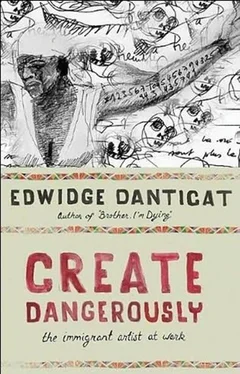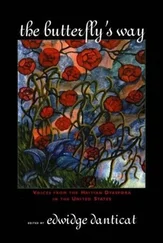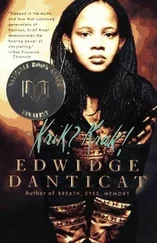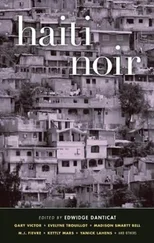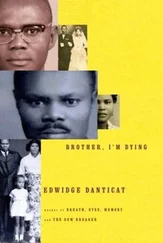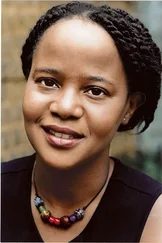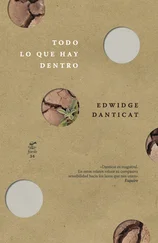“These are all body parts,” he says, “legs and arms that were pulled out the rubble and placed on the side of the road, where they dried further and melded together.” Sticking to several of the flesh-depleted legs are pieces of yellowed cloth-skirts, I realize, which many of the women must have been wearing.
Across the street from the remains, people line up to watch. One woman pleads with the crowd to repent. “Call on Jesus! He is all we have left.”
“We are nothing,” another man says, while holding a rag up against his nose. “Look at this, we are nothing.”
Jhon is a lively thirty-four-year-old who under normal circumstances has an easy laugh. He has been drawing and painting since he was a boy, using up leftover materials from his artist father. Later he attended Haiti’s National School of the Arts, and he has been painting and teaching art in secondary schools since he graduated. Even though he is at the beginning of his career, he has already participated in group shows in Port-au-Prince, New York, Miami, and Caracas, Venezuela. Jhon grew up in Carrefour, where Tonton Jean also lives. The epicenter of the earthquake was near Carrefour. A week after the earthquake, my husband and I were still trying to locate Jhon and Tonton Jean. Their cell phones were not working and, besides, they were both very busy. Tonton Jean was pulling people out of the rubble and Jhon was teaching the traumatized children in the tent city near his house to draw.
In the tent clinic at the general hospital, I find Maxo’s son Maxime, sleeping on a bench near where Maxime’s sister Monica is attached to an antibiotic drip. All around Monica, wounded adults and children lie on their sides or backs on military cots. Most of the adults have vacant stares, while the children look around half curious, examining each new person who walks in. I try to imagine what it must have been like in this tent and others like it during those first days after the earthquake, when, Tonton Jean tells me, people were showing up at the little clinic across the street from his house in Carrefour, without noses and ears or arms and legs.
In the tent clinic I say hello to Monica. She looks up at me and blinks but otherwise does not react. Her eyes are dimmed and it appears that she may still be in shock. To watch your house and neighborhood, your city, crumble, then to watch your father die, and then nearly to die yourself, all before your tenth birthday, seems like an insurmountable obstacle for any child.
Even before this tragedy, Monica was a shy girl. When I saw her during my visits to Haiti, she would speak to me only when she was told what to say. The same was true when I spoke to her on the phone. Now in the tent clinic, I give her a kiss in the middle of her head, where her hair has been shaved in an uneven line to place a bandage where a piece of cement had split open her scalp.
Before I leave the tent hospital, the blonde young American doctor who is taking care of Monica gives her a yellow smiley-face sticker.
“She’s my brave little soldier,” the doctor says.
I thank her in English.
“You speak English very well,” she says, before moving to the severely dehydrated baby in the next cot.
My next family stop is in Delmas, to see my Tante Zi. Though it had not collapsed, her house, perched on a hill above a busy street, is too cracked to be habitable, so she is staying in a large tent city in an open field nearby. We had talked often after the earthquake, and her biggest fear was of being caught out there in the rain. I had pleaded with her to go to La Plaine, where we had other family members, but she did not want to leave her damaged house, fearing that it might be vandalized or razed while she was gone.
When I reach Tante Zi’s house, some of the family members from La Plaine, including NC, are there too. We are too afraid to go inside the house, so we all gather on the sidewalk out front, which is lined with tents and improvised showers. It astounds me how much more of Haitian life now takes place outside, the most intimate interactions casually unfolding before our eyes: a girl sitting between her boyfriend’s legs on a car hood, a woman bathing her elderly mother with a bowl and a bucket. These are things we might have seen before, but now they are reproduced in some variation in front of dozens of shattered or nearly shattered houses on almost every street.
I hug NC and Tante Zi and six of my other cousins and four of their children. They tell me about the others. The cousin with the broken back may possibly be airlifted out of the country. The others from La Plaine were still sleeping outside their house but through a contact in Port-au-Prince they had gotten some water. Everyone had received the money the family had put together and wired them for food. Through all this, we hold and cradle one another, and while I hand them the tents and tarp they had requested, I start repeating something I hear Tonton Jean say each time he runs into a friend.
“I’m glad you’re here. I’m glad bagay la -the thing-left you alive so I can see you.”
Bagay la , this thing that different people are calling different things, this thing that at that moment has no official name. This thing that my musician/hotelier friend Richard Morse calls Samson on his Twitter updates, that Tonton Jean now and then calls Ti Roro, that Jhon calls Ti Rasta, that a few people calling in to a radio program are calling Goudougoudou.
“I am glad Goudougoudou left you alive so I can see you,” I say.
They laugh and their laughter fills me with more hope than the moment deserves. But this is really all I have come for. I have come to embrace them, the living, and I have come to honor the dead.
They show me their scrapes and bruises and I hug them some more, until my body aches. I take pictures for the rest of the family. I know everyone will be astounded by how well they look, how beautiful and well put together in their impeccable clothes. I love them so much. I am so proud of them. Still, I ask myself how long they can live the way they are living, out in the open, waiting.
Two of them have tourist visas to Canada and the United States, but they stay because they cannot leave the others, who are mostly children. NC does not have a visa. She wants a student visa, to continue her accounting studies abroad. She hands me a manila envelope filled with documents, her birth certificate, her report cards, her school papers. She gives them to me for safekeeping, but also so I can see what I can do to get her out of the country.
NC, like many of my family members in Haiti, has always overestimated my ability to do things like this, to get people out of bad situations. I hope at that moment that she is right. I hope I can help. I have sometimes succeeded in helping, but mostly I have failed. Case in point: my elderly uncle died trying to enter the United States. I could not save him.
I sleep in Carrefour to be closer to the town of Léogâne, where a few of my maternal cousins still live. Something close to 90 percent of the structures in Léogâne were destroyed in the earthquake, including a small pharmacy run by a young couple I know, both of whom were killed when their building crumpled on top of them. While driving through Léogâne one morning, Jhon and I spot, past a cardboard sign with a plea for food in the entryway of a makeshift refugee camp, a large white tent with a striking image painted on it: a stunningly beautiful chocolate angel with her face turned up toward an indigo sky as she floats over a pile of muddied corpses.
Jhon leaps out of the car to have a better look.
Misty-eyed, he whispers, “Like Picasso and Guernica after the Spanish Civil War. We will have our Guernica.”
“Or thousands of them,” I concur.
Читать дальше
